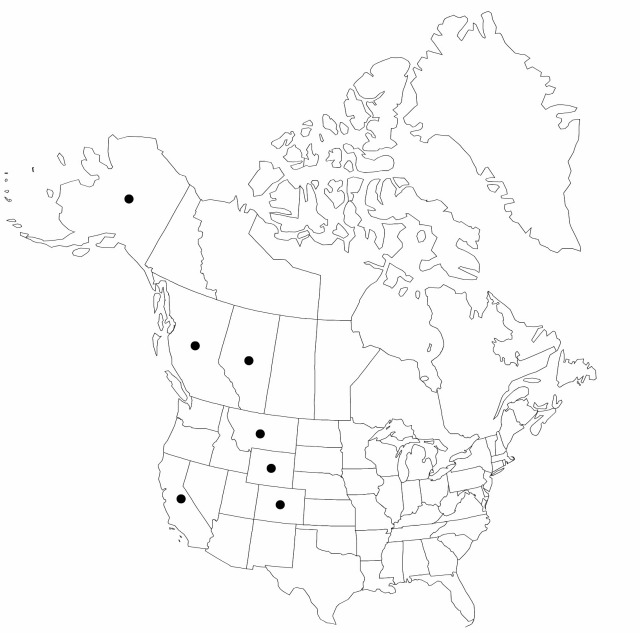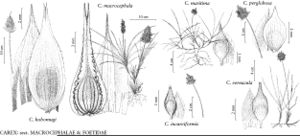Carex incurviformis
in P. A. Rydberg, Fl. Rocky Mts., 120, 1060. 1917.
Plants colonial. Culms curved, bluntly trigonous, 2–12 cm, smooth-angled distally. Leaves: basal sheaths brown; ligules 0.3–0.6 mm; blades involute, ± equaling culms, 0.5–1.5 mm wide. Inflorescences 0.5–1.2 cm; spikes (3–) 5–7, essentially indistinguishable in dense hemispheric head. Pistillate scales brown to dark-brown, with narrow whitish hyaline margins, ovate, conspicuously shorter than perigynia, apex ± acute to acuminate, body shiny. Anthers 0.9–1.4 mm. Perigynia light-brown proximally, dark-brown distally, usually strongly 8–11-veined abaxially, 4–11-veined adaxially, not or little inflated, narrowly elliptic, 2.9–3.9 × 1–1.5 (–1.6) mm, leathery, dull to satiny; stipe 0.2–0.4 mm; beak poorly defined, 0.4–0.9 mm, smooth or slightly scabrous-margined.
Phenology: Fruiting Jun–Aug.
Habitat: Alpine tundra, on wet gravels, rocky ledges, often in mossy turf or moss hummocks, usually uncommon
Elevation: 1900–4400 m
Distribution

Alta., B.C., Alaska, Calif., Colo., Mont., Wyo.
Discussion
Carex incurviformis is an alpine member of the C. maritima complex, and seems clearly (though subtly) distinct from the widespread and variable C. maritima, which in North America is a lowland and mostly coastal species. It is tentatively accorded species rank pending a comprehensive, worldwide revision of the complex even though, in other regions, apparently typical C. maritima does occur in alpine settings.
Plants of California especially and, to a lesser extent, the southern Rockies have broader, blunter scales with slighty wider hyaline margins than plants of the northern Rockies. California plants were described as Carex danaensis Stacey. As more collections accumulated, F. J. Hermann (1955) noted that the distinctions between C. danaensis and C. incurviformis were slight. He recognized C. danaensis only as a variety of C. incurviformis and expanded its range to include Colorado. With even more material the distinctions appear to be no more than a regional trend and are not given formal recognition.
Selected References
None.
Lower Taxa
"shortened" is not a number.
